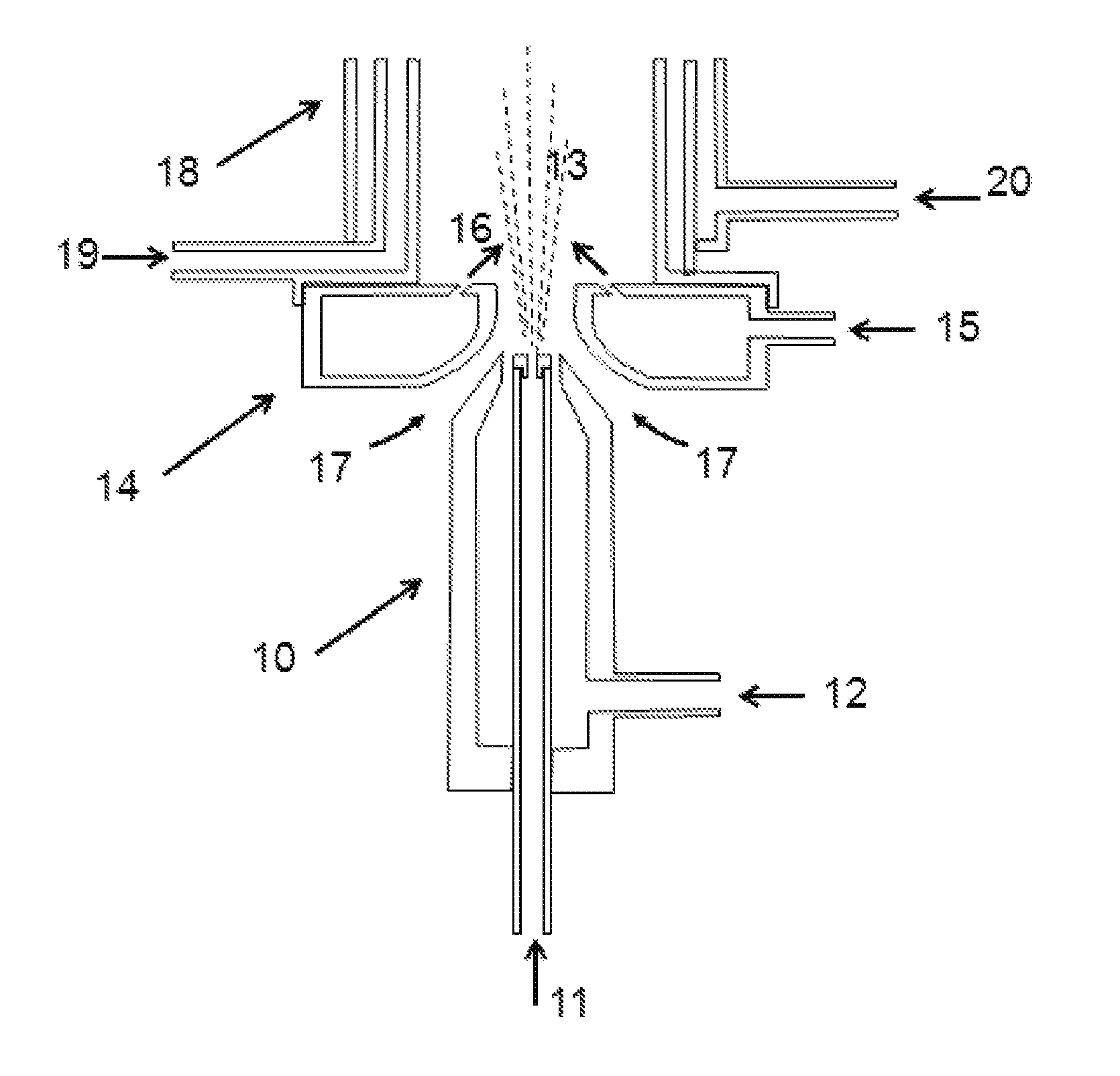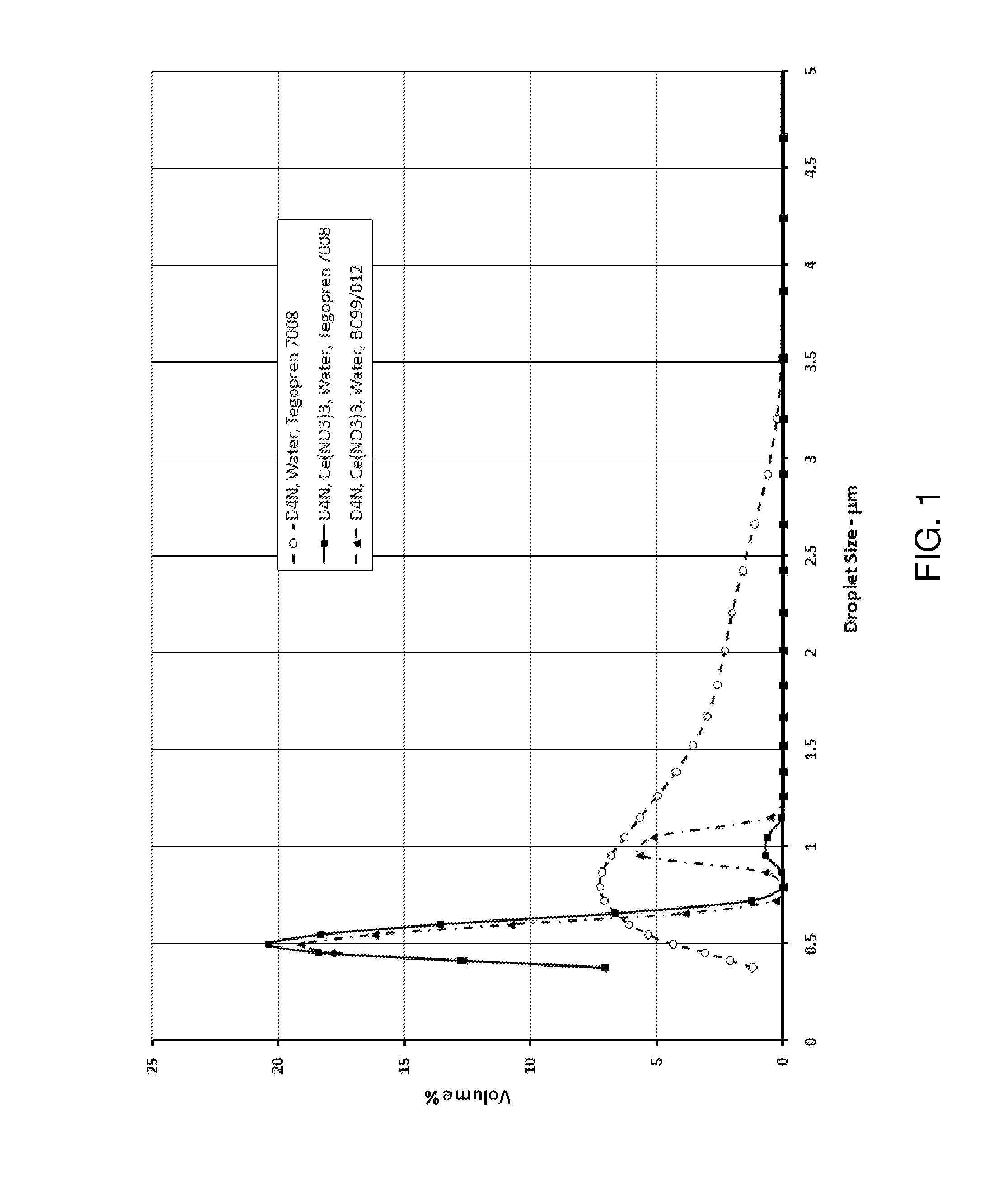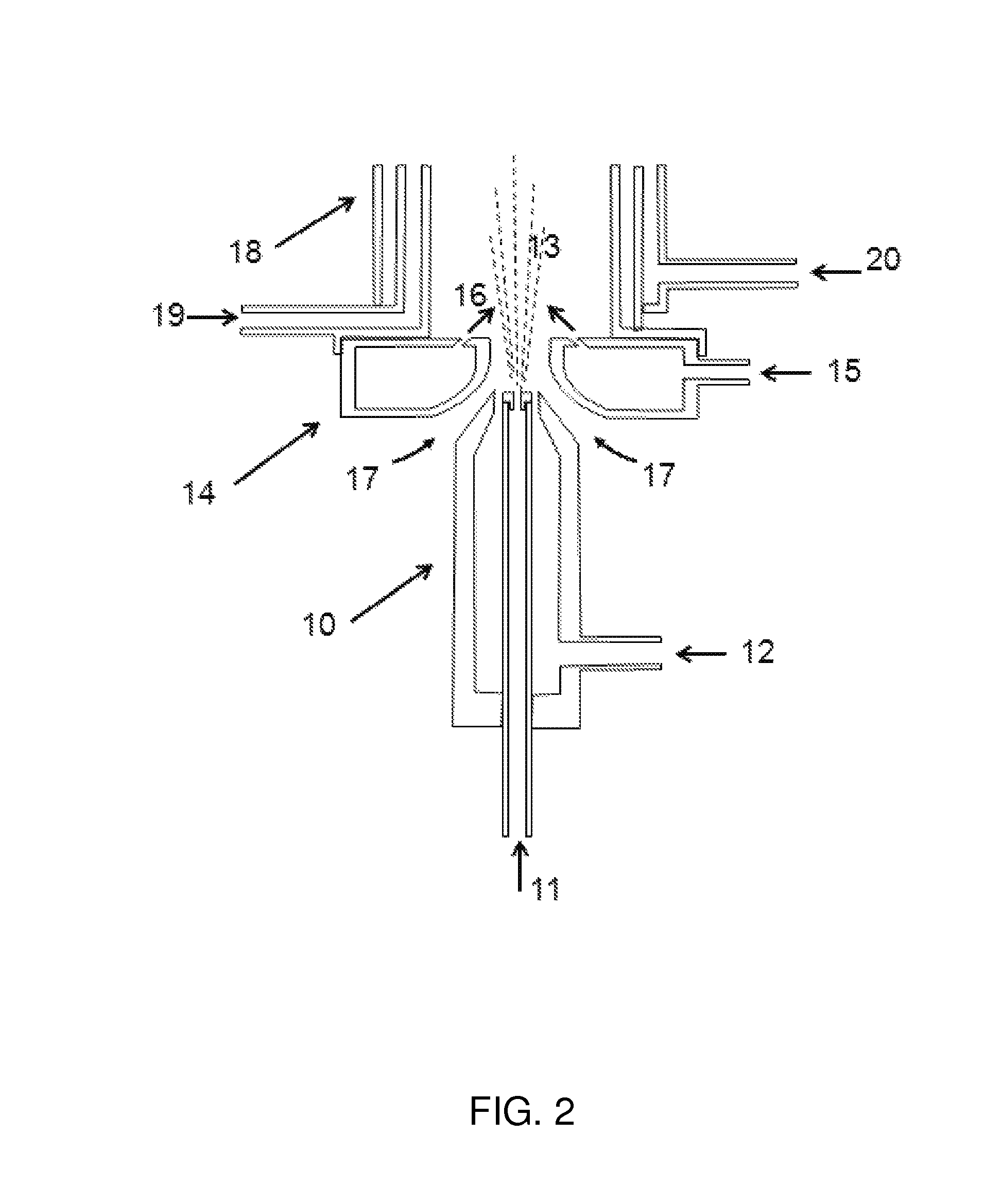A
soot deposition rate of 400 g / h was reported, but the effectiveness of converting a spray comprising separate droplets of silica precursor and
dopant is again questionable, and there are no indications of the quality of glass produced by this method.
However, the manufacture of high quality glass by spray
combustion is not without problems.
In U.S. Pat. No. 6,260,385 (column 2 line 61-column 3 line 8) it is noted that simple atomisation burners based on pneumatic (air-blast) atomisation may give unsatisfactory soot bodies with wart-like growth, unless the atomising gas is supplied at
high velocity.
This facilitates atomisation to smaller droplets and reduces the risk of incomplete vaporisation and
combustion before the droplets strike the substrate, but the increased flame turbulence has the
disadvantage of reducing the
soot deposition efficiency, and can give rise to other problems.
Defects in the soot body result if the precursor droplets are too large.
Alternatively, partial vaporisation and oxidation may take place in flight, but then
nucleation of silica may occur around the partially vaporised droplets, leading to oversized
soot particles.
These additions add greatly to the complexity of the process.
Where it is required to produce a doped synthetic
silica glass in which the
dopant oxide is
refractory, i.e. has high melting and / or
boiling point, and where it is required to make a glass uniformly doped at an atomic level, and free from bubbles and inclusions, the technique of spraying two liquids together into a flame raises further problems, unless the precursors can be fully vaporised and homogeneously mixed prior to, or in the course of, combustion.
Otherwise one or both of the precursors can become converted to a
solid or liquid particle whose size will depend on the
droplet size in the spray but generally, in the absence of total vaporisation of all the relevant species and homogeneous
nucleation and growth of doped glass particles in the flame, this technique cannot be expected to yield a doped glass of the required uniformity on an atomic scale.
One possible reason for the apparent failure of the atomisation approach is the relative difficulty of achieving a uniform spray, of uniform
droplet size, in a uniform gas flow, and thus to achieve vaporisation of all droplets, and then controlled combustion in a well-defined region of the flame, as required to generate a
high concentration of fully oxidised nanoparticles for collection on the substrate, uncontaminated by any unburnt particles of precursor, or oversized particles of
oxide or of other products of
pyrolysis of the precursor (e.g.
silicon carbide or oxy-
carbide) which might lead to defects in the product glass.
For deposition of doped silica using two or more precursors, there is the additional problem of ensuring intimate mixing of the constituent species, in constant and repeatable proportions.
Possible solutions to these problems were offered but the use of costly organometallic dopant precursors means that this technique is unsatisfactory as an economically viable method of producing the required doped glasses on a large scale.
Furthermore, there are numerous applications for doped vitreous silica products where no suitable organometallic precursors exist, or where the high cost of using such compounds would be unacceptable.
While some of these applications have been served in the past by fusing natural
quartz crystal powders intimately mixed with appropriate finely divided oxide powders, for certain applications today the methods previously used have proved to be inadequate.
In the past this has proved to be impossible to achieve on a large scale for many potential metallic dopants at an acceptable cost.
Particular difficulties arise when
doping by certain more
refractory oxides is required, and significant problems have been found with regard to homogeneous
doping of silica with the oxides of certain transition metals, and especially with the oxides of the rare-earth metals.
Furthermore, due to the difficulty in getting an ultimate solution of the rare-earth oxides in vitreous silica, because of their relative insolubility or “clustering” of the
metal ions in the glass, it has become conventional to co-dope with
aluminium oxide to aid the
solubility and dispersion of the rare-earth
metal ions.
As noted earlier, potentially volatile precursors of the rare-earth metals are either unavailable or very expensive, and are also difficult to
handle.
However, it would be difficult thus to ensure that the
lanthanum oxide species is generated in the form of ultrafine particles.
Furthermore, since the silica particles and dopant oxide particles are generated in two different regions of the flame, this approach is likely to give a soot-body in which the concentration of dopants fluctuates through the
layers of soot, and will not give the ultimate homogeneity and / or transparency required in the most critical applications.
In this arrangement, the silica soot, and such dopants as exist in the second spray, were laid down separately in successive
layers, which evidently cannot lead to the desired intimate mixture of components on an atomic scale.
However, as reported in other patents, such high velocities and turbulence are not generally conducive to efficient collection of soot in the form of a uniform porous body free from defects and well suited to
sintering to a defect-free glass, so while the approach may be suitable for deposition of small quantities of doped product, and capable of conversion to a high value optical fibre preform, from which
usable material may be selected, it does not appear appropriate for the efficient manufacture of larger quantities of homogeneous defect-free glass.
While the use of salts of dopant species fed as atomised aqueous solutions to the flame has been proposed in the past, the approach is unlikely to lead to total vaporisation of all potential precursor species, especially where these are relatively involatile.
Droplets of such solutions might be expected to evaporate to
dryness, and then to decompose to
solid or liquid particles, but because of the very high
boiling point of the dopant oxides of particular interest, some at least of the resulting oxide particles will remain of significant size, and will constitute unacceptable defects in the product glass.
 Login to View More
Login to View More 


